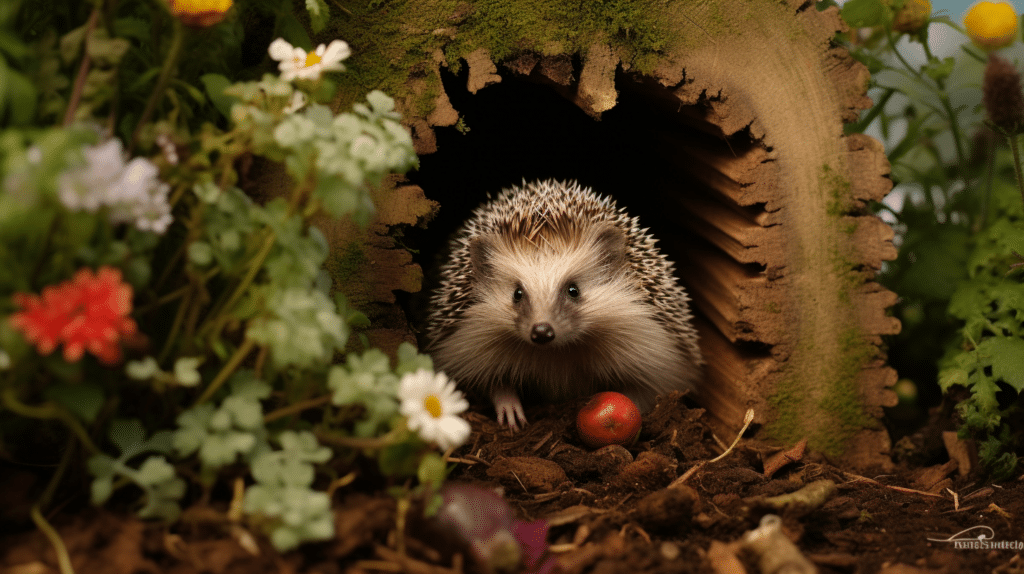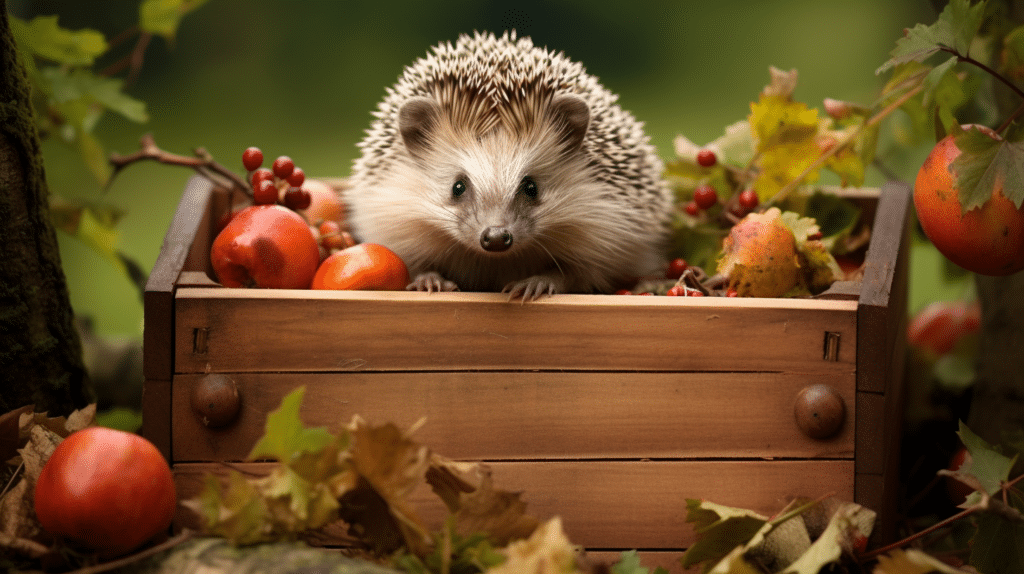Hedgehogs, scientifically known as Erinaceus europaeus, are small, nocturnal mammals adorned with distinctive spines covering their backs. They are native to the UK and Europe, celebrated for their gentle and curious nature. Hedgehogs boast an omnivorous diet, predominantly consisting of insects, slugs, snails, and worms, making them valuable allies in pest management.
However, hedgehogs have suffered significant population declines due to habitat loss, road accidents, and pesticide use. This decline underscores the importance of creating suitable habitats within our gardens to support these endearing creatures.
Creating a Hedgehog-Friendly Garden

Providing Shelter
Hedgehogs require secure and comfortable shelters for hibernation during winter and rest during the day. Here are some shelter options to consider:
- Hedgehog Houses: Invest in or make hedgehog houses designed to meet their specific needs, offering protection from the elements and potential predators.
- Leaf and Log Piles: Assemble piles of leaves, logs, and natural materials in a quiet garden corner, which hedgehogs can use as impromptu shelters.
- Compost Heaps: Hedgehogs may find compost heaps appealing for nesting. Ensure secure access and exits to prevent them from becoming trapped.
Providing Accessible Water
Hedgehogs need a source of fresh water, particularly during dry spells. Ensure they can easily access water by following these guidelines:
- Place a shallow dish of water in a quiet, shaded garden spot.
- Include a gentle slope or a ramp within the water dish to aid hedgehogs in escaping if they accidentally fall in.
Hedgehog-Friendly Fencing
Hedgehogs often travel between gardens in search of food and mates. To facilitate their movement, consider the following fencing strategies:
- Install a hedgehog-friendly fence with small gaps or holes at the base, allowing hedgehogs to pass through.
- Modify existing garden fences by creating small gaps at the base to enable hedgehog passage.
Wildlife-Friendly Plants
Selecting appropriate plants for your garden can attract insects and other natural food sources for hedgehogs. Native plants are an excellent choice as they support local wildlife. Here are some suitable options:
- Native Flowers: Include native wildflowers such as foxgloves, primroses, and bluebells to attract pollinators and provide insects for hedgehogs to feed on.
- Shrubs and Trees: Opt for shrubs and trees that produce berries, such as hawthorn and blackthorn, which offer additional food sources.
Creating Wildflower Patches
Allocate a portion of your garden to establish a wildflower patch. Wildflowers not only attract insects but also contribute to the natural beauty of your garden. These patches serve as vital food sources for hedgehogs and other pollinators.
Garden Maintenance and Safety

Leaving Wild Areas
While the allure of a meticulously manicured garden is tempting, retaining wild and overgrown sections can benefit hedgehogs:
- Wild areas provide hedgehogs with ample foraging opportunities for insects, slugs, and other food.
- Dense vegetation and undergrowth offer protection and nesting opportunities.
Avoiding Garden Netting
Garden netting can pose a serious threat to hedgehogs, potentially leading to entanglement and injury. To prevent accidents, adhere to these precautions:
- Minimise the use of netting whenever possible. If necessary, elevate it at least 15 centimetres above the ground to allow hedgehogs to pass safely underneath.
- Regularly inspect netting and remove it when not in use.
Setting Up Feeding Stations
While hedgehogs are natural foragers, supplemental food can be beneficial, particularly during periods of food scarcity. Here are guidelines for establishing feeding stations:
- Use specialised hedgehog food, readily available at pet shops and garden centres. These foods are nutritionally balanced for hedgehogs.
- Refrain from feeding hedgehogs milk and bread, as these can upset their digestive systems.
Creating Hedgehog Highways

To ensure hedgehogs can move freely and access different areas, consider the creation of hedgehog highways.
Connecting Your Garden
Hedgehogs frequently traverse multiple gardens in search of sustenance, mates, and nesting sites. Fashion gaps or tunnels in walls or fences to facilitate their seamless movement:
- Cut a small hole or tunnel, approximately 13 x 13 cm, at the base of your garden fence.
- Encourage your neighbours to adopt similar practices, thereby forming a network of interconnected gardens beneficial to hedgehogs.
Prioritising Safety
When working in your garden, exercise caution and remain vigilant for hedgehogs and other wildlife:
- Before utilising garden equipment like lawnmowers, strimmers, or rakes, inspect for hedgehogs concealed in tall grass or beneath leaf piles.
- Promote a safe garden environment by minimising the application of chemicals and pesticides.
Lighting Considerations
Nocturnal animals such as hedgehogs are sensitive to light, necessitating thoughtful garden lighting choices.
Nighttime Lighting
To avoid disrupting hedgehogs and other wildlife during the night, adopt these measures:
- Install motion-activated lighting as needed, ensuring it activates only when necessary.
- Use low-intensity, warm-toned LED bulbs to mitigate light pollution.
Monitoring and Education
Your efforts to cultivate a hedgehog-friendly garden can have a more profound impact when shared with your community.
Monitoring Hedgehog Activity
Stay vigilant for hedgehog activity in your garden, particularly during the evening and early morning hours. Employ motion-activated cameras or quietly observe from a distance.
Educating Your Family and Neighbors
Promote awareness regarding hedgehogs and their significance within the ecosystem. Encourage your family, friends, and neighbours to join you in creating hedgehog-friendly gardens. Share knowledge about best practices for hedgehog care and conservation.
Conclusion
By establishing a hedgehog-friendly garden, you contribute not only to the well-being of these charming creatures but also to the preservation of an iconic British species. Following the tips outlined in this guide enables you to create a sanctuary where hedgehogs can thrive and continue to be cherished residents of your garden for generations to come.
Additional Resources

Ash is a contributing author who has been writing about wildlife for as long as he can remember. He has a vast knowledge of many different types of animals, from the tiniest shrews to the great whales that live in the deepest oceans.
